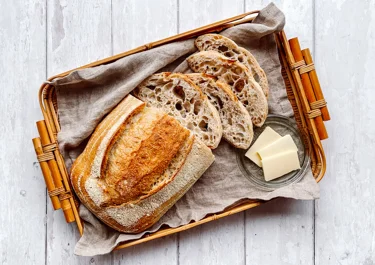Sourdough bread

Sourdough bread is not all that difficult with the right recipe and tips. Our recipe for sourdough bread is delicious, crispy, juicy, and ideal for beginners. If you have always wanted to try working with sourdough, start with this bread made with a sourdough starter. You can make the starter yourself or buy an active, ready-to-bake sourdough. Either way, you are in for a treat!
Ingredients
|
Water
|
350 ml |
|---|---|
|
Sourdough
|
150 g |
|
Honey
|
1 tbsp |
|
Wheat flour
|
300 g |
|
Italian wheat flour, for example, Tipo 00
|
200 g |
|
Coarse salt
|
1 tbsp |
Instructions
Tips
As a beginner in the big world of sourdough baking, if you are unsure whether your sourdough is active enough, add 5 g of yeast. This will ensure that the bread rises nicely and gets the characteristic sourdough flavour. You can also let the bread rise in a proofing basket which helps the dough maintain a beautiful shape while resting. Remember to sprinkle the proofing basket well with flour before placing the bread in it.
Tips
You can test if the sourdough starter is reading for baking by filling a cup with room-temperature water and dropping a scoop of the starter into it. If the starter floats, it should be ready for use; otherwise, it probably needs more time to develop. Though the test is simple, it is not as reliable as keeping track of the volume. Thus, the best way to check if the starter is ready for baking is to mark the height of the starter with a marker or an elastic band on the jar when you feed it.
Tips
Let the bread cool before slicing into it. It will allow the steam to release slowly and seal in the moisture and freshness, giving the bread a lovely texture. Place the sourdough bread on a cooling rack until it comes to room temperature, and then slice it.
Questions about sourdough bread
Who needs store-bought bread when you can make a delicious and aromatic loaf at home with our easy sourdough bread recipe? We have provided you with some interesting facts and information to help you achieve flavourful bread with a crispy crust. Read on to learn more!
What is sourdough bread?
Sourdough bread is a naturally leavened bread made with a sourdough starter. The starter is made by mixing water and flour and letting it sit to ferment while feeding the mixture continuously with water and flour. The fermented mixture contains lactobacilli bacteria and wild yeast that impacts the taste and texture of the bread, giving it a tangy flavour and rise.
How to make sourdough bread with starter?
Make sourdough bread by mixing the wet ingredients with the sourdough starter and then adding flour and salt. Let it rest to allow for the fermentolyse process to happen. Knead the dough in a mixer until it slips off the sides of the bowl. Once the dough is glossy and elastic, place it in an oil-covered bowl and fold and stretch it four times, repeating 4 times. Put a lid on the bowl and let the dough rise in the fridge for 12-24 hours. Shape the dough into a bread shape and let it rest for about 1 hour before sprinkling it with flour and giving it a lengthwise cut. Bake the bread in the oven for about 45 minutes.
How to store sourdough bread?
If you have not cut into the bread and it is still whole, you can store it in a paper bag or tea towel for 1-2 days. This will prevent it from drying out too fast. But it is important to allow the sourdough bread to cool before wrapping it or placing it in a bag. Once it has been cut, place it cut side down on a breadboard with a tea towel over the top; it will keep well for about 2 days without affecting the taste or texture. Afterwards, store the sourdough bread in a breadbox or bag. You can place the loaf in a freezer bag, but the crust will become softer as the moisture gets trapped inside the bag.
How long does sourdough bread last?
Sourdough bread stays fresh longer because it has a higher level of acidity. If you wrap and store it correctly, it will last about 3 to 5 days at room temperature. For the best taste, we recommend eating the bread within the first 2 days while it still has a crispy crust and a soft and airy inside.
Can you freeze sourdough bread?
Freezing sourdough bread is a great way to extend its shelf life. You can freeze it either whole or in slices for 2-3 months. Wrap the entire loaf or the slices tightly in cling film or foil and place it in a freezer bag before putting it in the freezer. You can place a sheet of baking paper between each slice, making it easier to thaw whenever you want a slice of bread. When you are ready to enjoy it, let the sourdough bread thaw at room temperature before refreshing it in the oven for about 10-15 minutes.
Why is my sourdough bread gummy?
If your sourdough bread is gummy, it may be because the sourdough starter has not yet matured, is under fermentation or is simply inactive. To avoid this, make sure you allow the starter enough time to mature and remember to feed it regularly with water and flour. When the fermentation has finished, the starter should have doubled in size with a smooth surface and lots of air bubbles; it is a sign that the starter is ready for making sourdough bread.
What does sourdough bread taste like?
The flavours in the sourdough bread are more emphasised compared to other types of bread as a result of using a starter instead of commercial yeast. The sourdough starter contains acetic and lactic acids that give the bread a sour and tangy flavour. If you want to enhance the tangy taste, you can increase the acids in the starter by letting more oxygen into the starter or letting it ferment longer.
How much starter for sourdough bread?
When making sourdough bread, you need to be aware of the ratio of flour and starter. You can calculate the amount of sourdough starter based on the total amount of flour used in the dough. As a rule of thumb, use 10-20% sourdough starter for the finished dough. However, we use 150 g of starter and 500 g of flour for our sourdough bread recipe, providing the dough with more hydration and a faster rise.
Artisan sourdough bread – crusty and airy
Who says you cannot make artisan bread at home? Most people think it is impossible to achieve tasty and beautiful sourdough bread without complex kneading techniques and expensive and complicated kitchen tools. But it is so much simpler. We have the best sourdough bread recipe for beginners with a crunchy crust, a soft crumb with big airy holes, and loads of delicious flavour. All you need is a sourdough starter, a handful of kitchen staples, and a mixer.
Cannot wait to test out your bread-baking skills? We have plenty of other bread recipes for you to try out. Check out our recipes for classic Danish rye bread, homemade fluffy white bread enjoyed with a cup of coffee, and scrumptious sunflower seed bread served with butter and cheese.
Get a hang of the popular bread
Making this popular creation may seem complicated, but with our basic sourdough bread recipe, you will quickly get the hang of it. The ingredients for sourdough bread are few and simple as you only need water, two types of flour, salt, sourdough, and a bit of honey to balance the tangy flavour in the bread. Of course, you will also need a bit of patience to get the perfect bread with beautiful air pockets and a crispy crust – but the recipe remains simple and straightforward if you just take it one step at a time.
How to stretch and fold sourdough bread
The act of stretching and folding the dough helps strengthen it so the sourdough bread can hold its shape, and it will improve the gluten network, which means it will hold the air bubbles better, making a more beautiful bread with bigger holes. Grab a portion of the dough and stretch it upwards before folding it over towards the centre. Give the dough a slight turn and continue stretching it upward and folding it towards the centre. Repeat the process until the dough has been stretched and folded four times from each side – think north, south, east, and west. Then, let it rest.
You can repeat this process 4 times every 30 minutes (2 hours in total) or once per hour (4 hours in total). It helps activate the gluten so you, as mentioned, get a dough that will hold its shape before and during baking – also, it makes it much easier to work with for you. It also gets more air into the dough, so you get the characteristic air pockets after baking.
Enjoy the tanginess of sourdough bread
Enjoy a crackly crusted bread with an airy texture and a hint of tanginess. The bread gets its distinct flavour from an active sourdough starter containing lactic acids that give a sour taste and keep the bread fresh longer. The tangy aroma sets this bread apart from other types of bread, creating a memorable flavour experience. Treat yourself to a slice of this delicious and freshly baked sourdough bread in the morning, for lunch, or in the afternoon. The tangy taste goes well with almost anything, whether you are using it with a sweet strawberry jam in the morning or in savoury sandwiches later in the day.
Add your own touch
Give the sourdough bread a sweet or savoury take by adding a few ingredients to the dough. Depending on what you are adding to the recipe, it should not be more than 20% of the total amount of flour (500 g) needed for the dough. For example, if you want to add cheddar, use no more than 100 g.
For a sweet take, add cinnamon, raisins, and apples to your bread. The apples and raisins complement each other and make for a sweet and slightly tart flavour. Make sure to add raisins and apples during the kneading stage to keep the ingredients inside the bread and prevent them from being on the surface during baking and potentially getting burned.
Need something hearty to go with your soup? Then a roasted garlic and rosemary sourdough bread is just what you are looking for. The roasted garlic gives the bread a gorgeous depth of flavour that is intensified with a hint of fresh rosemary. Roast the garlic on a pan drizzled with olive oil and let it cool slightly before adding it to the resting dough along with chopped rosemary. Shape and bake the bread.








